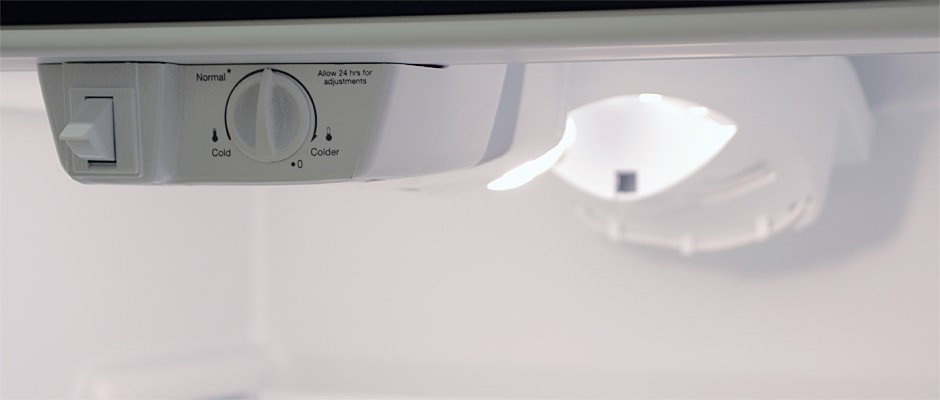Introduction
Design & Usability
This Frigidaire by any other name would look like... well, a cheap Frigidaire.
We've seen products like this before: stainless steel with a prominent grain in the finish, cheap plastic drawers, and a control knob that makes temperature setting a crapshoot. The full-width shelves in the fridge make for easy access to most areas, utilizing a design that no consumer should find surprising assuming they've opened a refrigerator within the past thirty years or so. Despite sticky crisper drawers and a lack of any spill containment on the door—we've never understood the use of gaps between a shelf and its front edge—it's not a bad fridge, just an unimpressive one.
{{photo_gallery "Front", "Fingerprint", "Handle", "Interior", "Fridge", "Controls", "Crisper Drawer", "Fridge Door", "Freezer", "Ice Maker", "Freezer Door", "Side", "Back"}}
Performance & Features
Some outside assistance required.
Our approach to fridge calibration is as follows: if there's no actual degree scale on the control panel, we're going to set the dials to a recommended manufacturer mark if one is found. We figure that's what the average consumer is going to do, and we want to treat our products roughly the same way that you would. With that in mind... you'll need to buy an external thermometer if you buy this fridge.
Temperatures were wonderfully consistent over time; the catch is that the "Normal" mark puts the fridge at about five degrees warmer than we'd like (our ideal is 37 degrees Fahrenheit), while the freezer was a full 15 degrees warmer than it should have been. If a "Normal" setting on an ambiguous control panel sets things just a little too warm or a little too cold—we're talking a degree or two—that's acceptable; 5 to 15 degrees, however, is just not acceptable. An external thermometer should be a suggestive tool for optimization—not a base requirement.
Everything else about the fridge's performance, much like its approach to design, was solidly average. Moisture retention in the crispers was adequate, energy efficiency was adequate, and storage space was adequate for a fridge of this size and layout. There was simply nothing about this fridge that wowed us, but by that same token—temperature calibration aside—there wasn't really anything that truly disappointed us, either.
Conclusion
No great loss to the Frigidaire stable.
As we mentioned, the FFHI2117LS was very recently discontinued by Frigidaire. Frankly? No one's going to lose sleep over it. With a mediocre design, major calibration issues, and ho-hum performance all around, there's nothing about this product that makes it stand out from the pack...at least, in a positive way. For some reason, this over-priced top freezer was given the impressive MSRP of $979; now that it's discontinued, any one that you find will likely be a bit cheaper (we found some at discount online retailers for about $929). Even with a little bit taken off the top, however, this fridge really isn't worth it. You can find much better models at a much better price without looking too hard; a fridge this quality should really only be costing you no more than about $700, maybe $750 if it has a really nice finish.
Introduction
Putting aside any issues we had with any usability issues, it's clear when you look at the numbers that this fridge just doesn't cut it. Don't believe us? Take a look for yourself.
Temperature Performance
A good starting point makes all the difference.
The biggest issue here isn't actually consistency, it's calibration. The fact that there are two separate control knobs—one for the fridge, one for the freezer—means getting the compartments to behave the way you want them to temperature-wise is actually easier than on many other budget top freezers. The hard part is finding the sweet spot that gets you the temperature output that you want for food preservation.
Using the "Normal" mark on both control knobs, we found that this fridge ran very warm. The fridge averaged 41.69 degrees Fahrenheit, running about a degree and a half cooler at the top with the converse happening at the bottom.
The top of the freezer clocked in at 11.64 degrees, while the bottom—keep in mind that the distance here is not a large one—came in at 16.57 degrees (a five degree variance!) with an overall average throughout of 14.1 degrees. That's just plain bad, folks; you're essentially being forced to go out and buy an external thermometer or risk spoiling all your frozen food. To add insult to injury, we saw degree shifts over time ranging from 0.7 degrees (just barely acceptable) to 3.27 degrees (bring on the freezer burn, baby).
{{photo_gallery "Fridge Temperature", "Fridge Temp Graph", "Freezer Temperature"}}
Moisture Retention
Fresh salad? Eh...I suppose so.
The moisture retention on the Frigidaire's sticky crisper drawers landed just inside of what we would call an acceptable range...but only just. After three days in the fridge, we found that our test material lost an average of 0.18 grams of water per hour. It's alright, but don't plan on preserving your veggies beyond a few days, otherwise you'll likely notice a decrease in quality.
Freezing & Thawing
This freezer brings cold comfort.
If only the freezer temperatures were more consistent, we might actually be excited about the results of our freezing test. Room-temperature test materials frozen in just one hour and 29 minutes after being placed inside the Frigidaire. That's actually quite good; anything under an hour and a half is pretty fast, locking in quality and nutrients that might be lost if it took longer.
The insulation here also did its job, keeping everything frozen even without power. Despite the fact that the average freezer temp was substantially warmer than the ideal, it still only hit 28.87 degrees 36 hours after being unplugged.
{{photo_gallery "Freezing Graph", "Thawing Graph"}}
Storage Space & Energy Efficiency
A budget fridge with average space. Anyone surprised?
The design of the Frigidaire is a very familiar one, and as such, the amount of available storage shouldn't come as much of a surprise. Taking into account space that's lost because of the large fridge light fixture, the multiple shelf and drawer layout inside the fridge and on its door totals 10.75 usable cubic feet. It's not bad for a fridge this size, but it's not exactly cavernous, either.
The freezer, with its single shelf and the surprising inclusion of an ice maker, offers up a slightly less impressive 3.86 cubic feet. That number subtracts space taken up by the ice maker, but we did remove the ice bin; keep that in mind if you intend to use both, as that will impinge upon usable storage.
In terms of energy efficiency, we—yet again—were neither impressed or dismayed. It was, in a word, fine. An annual electric bill for this fridge would total $33.43 based on an average cost of $0.09 per kWh. It's not the cheapest fridge out there—in fact, it's edging towards the expensive end for budget fridges this size—but it's still quite acceptable. When you take that power and spread it out over all the usable space, it turns out that this Frigidaire requires only 0.07 kWh per cubic foot, which is a very satisfactory number.
{{photo_gallery "Fridge Storage", "Fridge Door Storage", "Freezer Storage", "Freezer Door Storage", "Power Data"}}
Meet the tester
Matthew is a native of Brockton, MA and a graduate of Northeastern, where he earned a degree in English and Theatre. He has also studied at the Gaiety School of Acting in Dublin and spends most of his free time pursuing a performance career in the greater Boston area.
Checking our work.
Our team is here for one purpose: to help you buy the best stuff and love what you own. Our writers, editors, and lab technicians obsess over the products we cover to make sure you're confident and satisfied. Have a different opinion about something we recommend? Email us and we'll compare notes.
Shoot us an email


